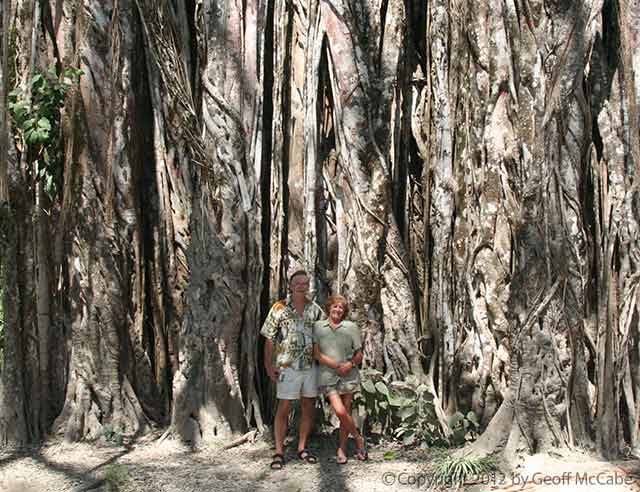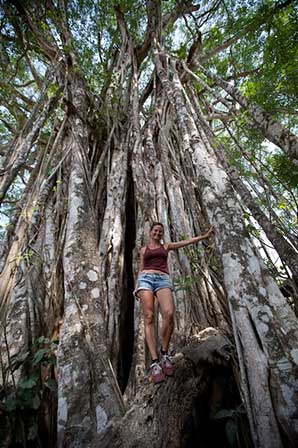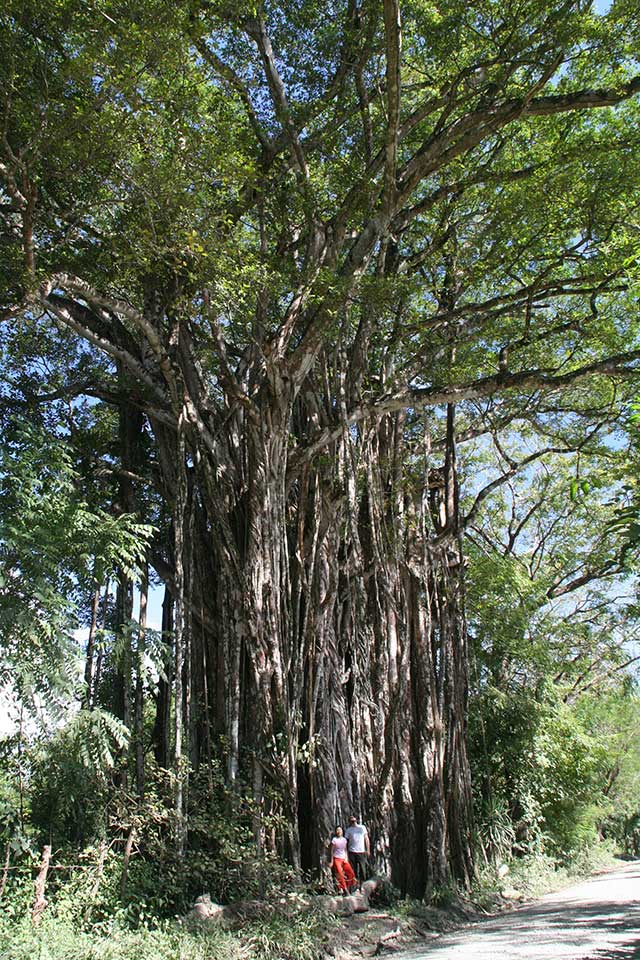- Home
- Accommodation
- Activities
- Area Info
- Maps
- Photo Galleries
- Real Estate
- Travel
El Higueron de Cabuya (Giant Banyan Tree)

There’s a giant banyan tree, known as an Higueron (fig) in Spanish, on the main road from Montezuma to Cabuya. It’s on the west (right) side of the road as you’re heading towards Cabuya… impossible to miss because of it’s immense size.
Most tourists to the area discover it by accident while exploring the area and stop their cars for a photo op.
Giant higueron trees like this are very important parts of the jungle. All those natural cracks, crevices, holes, and caves in its multiple trunks and interwoven branches are home to so many different creatures.
Someone who has lived here for years once told me that in Santa Teresa, there used to be another one of similar size, but the owner cut it down to make concrete molds. Happily though, this giant in Cabuya has survived the ages. An old man who has lived in Cabuya for more than 80 years says that when he was a child, this tree seemed no smaller than it does now. So how old is it? No one knows.
Award Winning Tree
In 2009, INBIO awarded this tree with the national prize as “most exceptional” in the country of Costa Rica. Every year there are many nominations, but only one winner. To enter your tree into the contest, click here: Most Exceptional Tree in Costa Rica Contest
The Biggest Tree in Costa Rica?

Yoga instructor Angela Boltz with giant strangler fig.
Since I’ve lived in Costa Rica, I’ve asked many Costa Ricans and people who have traveled extensively throughout the country, whether they’ve ever seen a bigger tree here, and no on has. A google image search of “biggest tree in Costa Rica” and other similar terms will turn up many contenders, including photos of this one. You’ll be able to see there aren’t any photos showing a wider tree. But the “biggest”? I suppose that depends on what you mean… widest, heaviest, tallest? As far as I know, Cabuya’s higueron hasn’t ever been certified as the biggest, but that doesn’t mean that it isn’t.
The Strangler Fig Tree
Another name for this type of tree is “Strangler Fig“, or “Matapalo” in Spanish. It grows when a seed is pooped out by a bat or bird and lands inside another tree. It grows very quickly, sending roots down to the earth as quickly as its branches grown upwards. It grows more quickly than its host tree and soon its branches will out grow the top of the existing tree, at which point it really gets going. Contrary to popular belief, it doesn’t strangle or squeeze its host. It doesn’t penetrate its bark either. It exists on the outside and kills it by outgrowing it and stealing its sunlight, eventually shading it out. When a strangler fig kills a really large tree, the older tree sometimes will rot out from within it, leaving a huge hollow tunnel inside. In the Osa peninsula’s town “Matapalo” such a tree exists that you can see and you used to be able to rappel down the inside.
Nick Woolsey’s has a great fire-dancing video with nice scenes of this tree:
Great Stuff

Clandestina Restaurant
My new favorite restaurant, Clandestina is not to be missed by food lovers staying anywhere near to Montezuma. Established in March 2015, Clandestina is the new kid on the block. The Oregon/Tico collaboration is a winner among locals and travelers alike, with artisan craft beers, made onsite by Butterfly Brewing Co. and delicious, exciting […]












